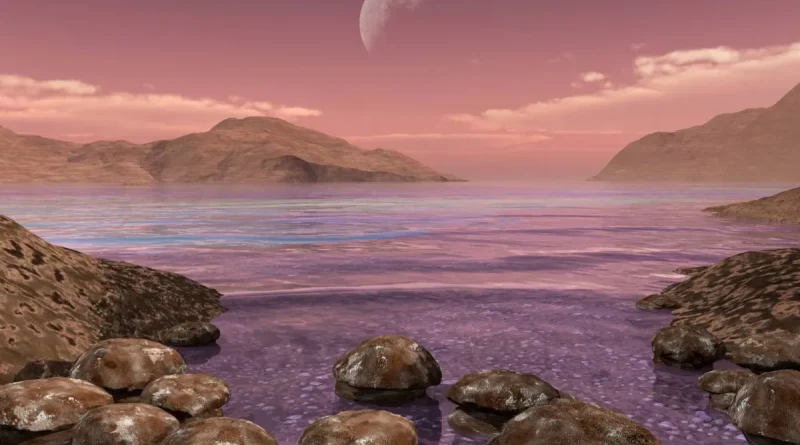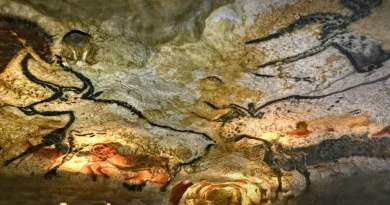How did the earth become breathable?
The Great Oxygenation Event, which occurred about 2.4 billion years ago, was one of the biggest events in the history of planet Earth. Prior to this event, there was no oxygen in the atmosphere.
Typically, the increase of oxygen is considered as a factor in creating life on Earth and it is believed that Earth itself did not play an active role in the emergence of life. But the Earth was also an active participant and increased oxygen twice during two billion years before reaching breathable levels. So, which case was responsible for the increase of oxygen on Earth: life evolution or planetary evolution? Nature or nurture? And does the same answer apply to all cases of oxygen increase in Earth’s past?
This question goes beyond curiosity about Earth’s past, as it also affects how signs of life are interpreted on exoplanets. Below is the story of the oxygenation of Earth’s atmosphere from Ars Technica website.
Alien Earth
Almost half of our planet’s existence (during the period before the Great Oxygenation Event or GOE), the Earth was practically an alien and different planet. In addition to the fact that the air was not breathable, the oceans were also devoid of oxygen and rich in soluble iron, while the Earth was under deadly ultraviolet radiation because the atmosphere lacked an ozone layer. Even the color pattern of the Earth was alien: the Earth lacked the red soil colors and vegetation greenery, while the sky was orange to pinkish due to high levels of methane.
Life began in that alien environment and at some point between 3.2 billion and 2.8 billion years ago, cyanobacteria began using sunlight to separate hydrogen from water and release oxygen as a by-product. This period was 400 to 800 million years before the great oxygenation event. Dr. Benjamin Mills of the University of Leeds says, ‘Life set these reactions in motion that produce oxygen, but what we know from geological records is that this did not immediately lead to a significant increase in oxygen in the atmosphere.’
It is clear that the invention of oxygen-producing photosynthesis was not sufficient in itself to oxygenate the atmosphere.
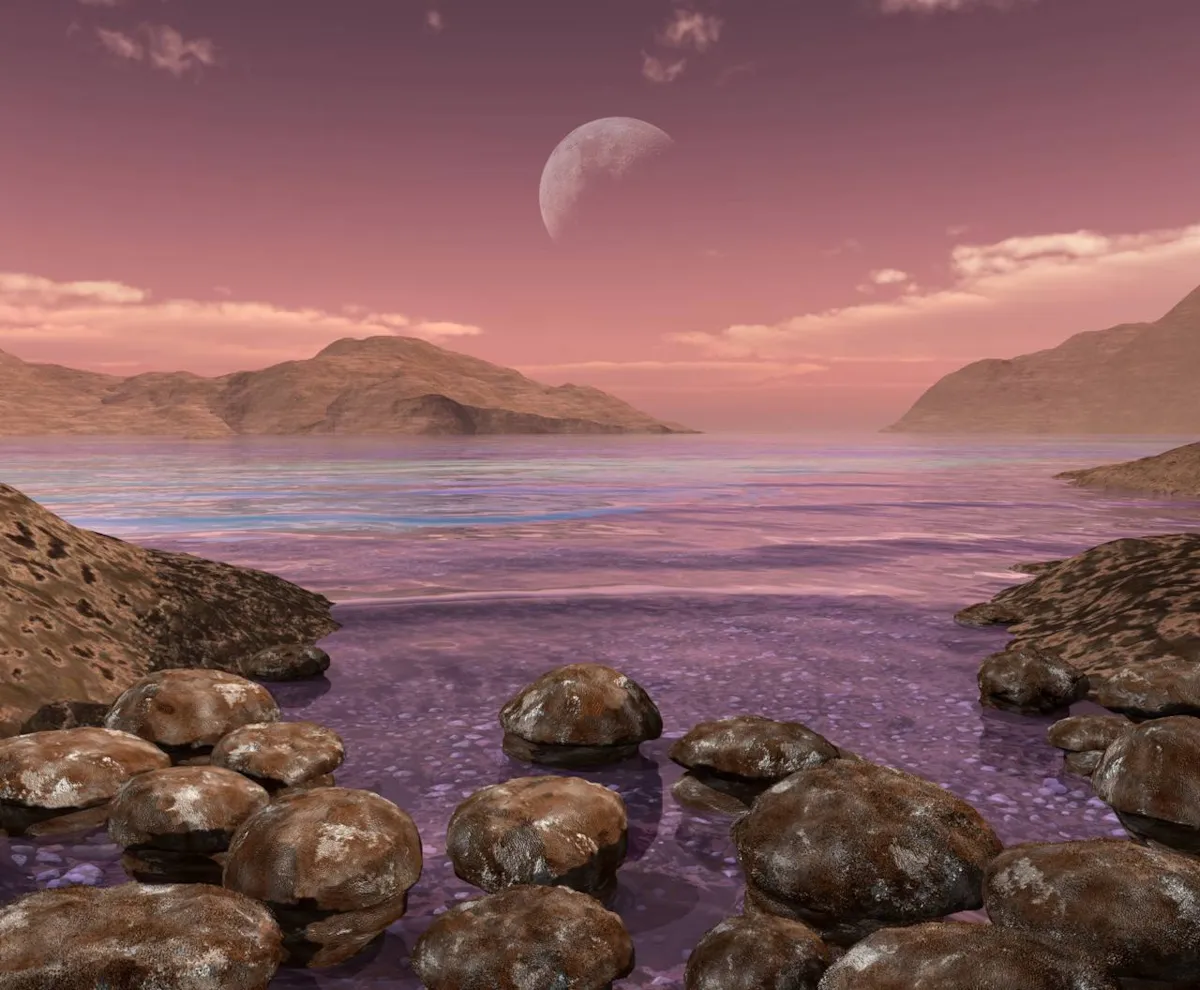
Artistic representation of Pre-oxygen Earth: Microbial stacks under a Methane sky Û³ billion years ago
Earth as an oxygen producer
Every day, Earth sends about 90 tons of gas (mostly hydrogen and helium) into space. This amount is negligible compared to the mass of the atmosphere, so there is no reason to worry.
Before the Great Oxygenation Event, the loss of hydrogen into space had been so great that it caused an imbalance between hydrogen isotopes, as hydrogen, being lighter, escaped more easily from the atmosphere than did its heavier isotope, deuterium. This imbalance is indicative of the loss of a quarter of the planet’s original water, the equivalent of an entire ocean. Professor Rajdeep Dasgupta of Rice University explains, ‘The Earth started off with more water, but ended up with less because it lost hydrogen, which escaped more easily due to the planet’s early conditions.’
The loss of water’s hydrogen, however, preserved the oxygen and turned Earth into an oxidizing environment. This same phenomenon is present on Mars. Mars has enough oxygen that, after the loss of hydrogen from its water into space, it remained and reacted with the planet’s surface to turn it red through a process called oxidation.
On Earth, with its more active geology, there were additional materials present to react with the oxygen. Dasgupta explains, ‘The accumulation of oxygen in the atmosphere doesn’t just depend on how oxygen is produced. It’s also dependent on how it’s destroyed.’
The early Earth’s atmosphere was rich in oxygen-consuming gases such as hydrogen, carbon monoxide, hydrogen sulfide, sulfur dioxide, and methane. These gases were continuously released by volcanoes and, also, through reactions with seawater and rocks, as well as by microbes. Hydrogen from the reaction of seawater and rocks consumed more than 70 million tonnes of oxygen annually. The oceans were also rich with dissolved iron that reacted with any dissolved oxygen and consumed it.
Overall, these gases consumed oxygen as soon as it was produced. Mills says, ‘Just producing enough oxygen is not enough to fill the atmosphere with oxygen, you have to produce enough oxygen to fill it with oxygen thousands of times over to keep oxygen in it.’
To get more oxygen on the planet, cold was needed. When the earth cooled enough, its crust began to move in the form of hard plates and sent materials inside and helped cool the interior of the planet. As a result of this, the Earth turned from a blue world with scattered volcanic islands into a world of continents and mountains.
The thickening of the Earth’s crust increased the local depth where magma was stored before eruption, increasing pressure on the materials in the depths of the Earth. This simple change altered the chemistry of molten rocks and thus the chemistry of the gases released by volcanoes. Das Gupta explains, ‘In one state, when the shell is thin, you will have reducing gases. In another state, when the shell is thick, you will have more oxidized gases.’ Therefore, the production of oxygen-consuming gases decreased with the growth of the continents. ‘
Death releases free oxygen for living organisms
Before the continents, the loss of vital nutrients like phosphorus in the oceans may have limited the abundance of life to less than 7 percent of today’s living mass. This had kept the population of cyanobacteria in check and suppressed oxygen production. But as the continents grew, more nutrient erosion entered the oceans, and as the chemistry of the glasses changed in sync with the growing continents, nutrients were released from phosphorus-rich rocks and increased the amount of life that the Earth could support.
As life flourished in the oceans, it strengthened a process known as the ‘sea carbon pump’. Today, the entire population of plankton in the surface layer of the world’s oceans is destroyed by planktonus and viruses every few days. While most of the carbon in this massacre returns to new life, some of it is buried in the seabed. Apart from the presence of feeding organisms, a similar event was happening on the early Earth.
Organic carbon also reacts with oxygen to produce carbon dioxide. Therefore, to accumulate oxygen in the atmosphere, organic carbon must be buried. In other words, burying carbon increases oxygen.
With the growth of continents, the amount of iron washed and entered the oceans also increased. This iron was attached to organic carbon and prevented carbon recycling by microbes until carbon was safely buried and therefore the amount of carbon burial increased. Moreover, larger continents provided more space for sedimentary basins that also buried organic carbon and helped increase oxygen.
Shaky Transition
With all these factors, the great oxygenation event was not a simple on/off switch. The sedimentary records show oxygen pulses that started hundreds of millions of years before the event and fluctuated over 200 million years. Professor Ariel Anbar from Arizona State University says, ‘As the flow of oxygen-consuming gases declines over time, you get closer to a point where the system ultimately flips. As you approach the flipping point, the stability of the system must gradually erode.’
The change in oxygen status plunged the planet into crisis. Anbar says, ‘Because of the methane greenhouse gas, the earth stayed warm, and then oxygen came in and as the greenhouse gas was removed, eventually, the ice ages occurred.’ As a result, the earth immediately after the GOE entered a series of ice ages known as ‘Snowball Earth’ that lasted around 220 million years.
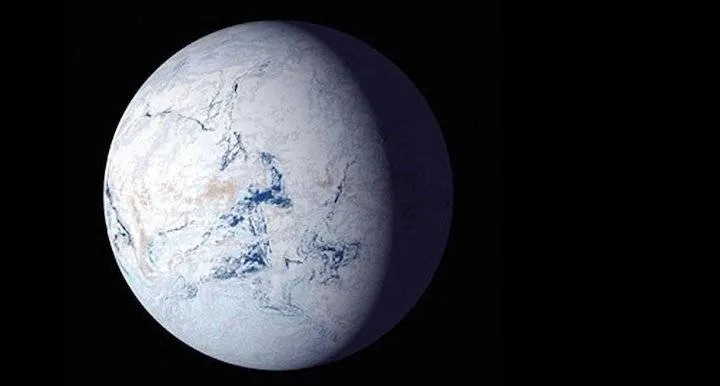
Approximately 650 million years ago, the Sturtian glaciation turned the Earth into a snowy ball. When the planet warmed up again, it released phosphates, oxygen, and other elements required for multicellular life.
The GOE event changed the composition of the earth by creating around three thousand oxidized mineral substances that did not previously exist. Sunlight converted some of the atmosphere’s oxygen into ozone and formed a layer that acted as a shield against UV radiation. Methane, as a result of oxidation, produced carbon dioxide and caused the sky to turn blue. Currently, along with carbon dioxide emitted from volcanoes, the earth has enough greenhouse gases to prevent freezing.
Iron soluble in the oceans mostly deposited as iron ore, which is extracted today. It reacted with hydrogen to produce water and reduced its escape to space, keeping the Earth’s oceans constant. A new type of cell (eukaryote) evolved, many of which had oxygen-dependent metabolism. Ultimately, this made the emergence of complex life possible. However, breathable oxygen has not yet been realized and remains at one percent of current levels.
Of course, the production of oxygen-free volcanic gases did not control oxygen, as geochemical data shows that these gases have decreased over time. If they controlled oxygen levels, oxygen levels should have gradually increased.
This oxygen-depleted state lasted for one and a half billion years, coinciding with a period of geologic inactivity known as the Uniform One Billion Years. Although the causes and consequences of this period are unknown, it seems that during this period there was a limited mountain-building activity with a supercontinent. The mountains turned into hills due to erosion, and their nutrients were destroyed by weathering or locked in dry soils and were unable to nourish marine life. Although the ocean surface still contained oxygen, its depths remained without oxygen, and soluble iron accumulated again.
The repository said, ‘If oxygen exists in the seawater, it is difficult to solve a large amount of iron in it.’
The Precambrian Oxygen Event
One and a half billion years after GOE, the earth experienced its second major increase in oxygen levels, which is known as the Precambrian Oxygen Event (NOE), which took place about 800 to 500 million years ago and brought oxygen to half of today’s levels.
Although the details are discussed, it is believed that NOE had a lot of similarity to GOE and there were large fluctuations in oxygen for about 300 million years. The event was similar to GOE, with significant evolutionary advances in life as well as changes in plate tectonic style. After this event, the earth’s snowballs occurred. Again, the oxygen on earth was oscillating. Mills says, ‘You enter this unstable period that seems like a natural event that occurs when the ocean becomes oxygenated. If you have an ocean that has oxygen, suddenly you change a series of things. You change the minerals that are supposed to form and remove phosphorus from the ocean. Therefore, when you oxygenate or deoxygenate the oceans, you can see a completely dynamic change.’
Could new life forms have been the driving force behind the previous oxygen event?
At that time, there was a significant variety of life and evidence of ‘estrane’ is also seen. This chemical compound is a biological indicator of eukaryotic cells that shows their abundance at that time.
The first animals also evolved around that time. Professor Tim Lenton of the University of Exeter has suggested that evolution led to more efficient burial of carbon, as new life forms were larger, so they settled in the seabed faster and protected more carbon from recycling.
Although this idea is controversial, there is evidence that suggests algae may have started life on land at that time. In this case, the organic acids that algae used to extract nutrients from rocks increased the influx of nutrients into the oceans.
The significant increase in carbon isotopes buried in organic carbon at that time indicates an increase in oxygen. Algal rock weathering and increased carbon burial also cooled the climate and probably triggered the Earth’s snowball glaciations.
Active role of the Earth
But life may not be the whole story, as the Earth itself was also changing during NOE. Plate tectonics came to an end of a billion-year uniform period by breaking up the supercontinent Rodinia into several smaller continents that scattered in tropical regions. The process of mountain building resumed and volcanoes erupted again with force as the continents slid over oceanic plates.
The Earth was beginning a new style of plate tectonics, whereby colder plates produced a new set of rocks called blueschist when they moved and subducted at high pressure.
Early in Earth’s history, when the planet was hotter, most plates would melt upon entering the mantle, but during NOE, the planet had cooled enough that most plates that subducted did not melt. The new style of plate tectonics caused more stable subduction of the plates into the mantle, which led to an increase in continental crust and sent a lot of carbon deep into the Earth. It also made mountain belts thicker. More nutrients and iron were sent into the oceans via erosion, increasing biological activity, burying carbon, and increasing oxygen.
Once again, Earth shifted towards climate inversion and nutrient movement. Two Snowball Earth periods occurred, in which the planet was covered in more ice for tens of millions of years, each followed by the greenhouse conditions, which unleashed a flood of nutrients from crushed rock into the oceans via glacial rivers. Oxygen remained oscillatory for a long time after that, and one low-oxygen period caused the oldest mass extinction of primitive animals about 550 million years ago.
Nevertheless, life continued to evolve in more energy-demanding lifestyles that required higher levels of oxygen, with larger-bodied organisms that searched the sea floor and moved with their own power. Inbar said, ‘Oxygen production allowed for a fundamental change in the type of life that could exist. Since suddenly there was a lot of energy available, aerobic metabolism evolved, which is metabolism at higher energy levels. Then the evolution of more complex forms of life began.’

The final increase in oxygen -the Paleozoic oxygen event, or POE- began about 470 million years ago. This increase is better understood: the evolution of land plants. Mills states: ‘Land plants certainly increased the amount of oxygen, and now we’re absolutely sure that their evolution was a prerequisite for the oxygenation necessary for animals like us to breathe.’
The reason is once again the burial of organic carbon. Mills explained: ‘Plants have to make their bodies differently than algae and bacteria because they have to remain vertical. This requires more carbon in bodies. They can bury more carbon. At this point, the amount of carbon in buried materials increased tenfold.’
In a weak repetition of past oxygenic events, POE also had another severe glaciation. Although this glaciation was much shorter, sea levels plummeted and large portions of oceans lost their oxygen again, resulting in a large mass extinction. But compared to past periods, this glaciation was relatively short and oxygen levels soon supported high-energy life forms such as fish and terrestrial animals.’
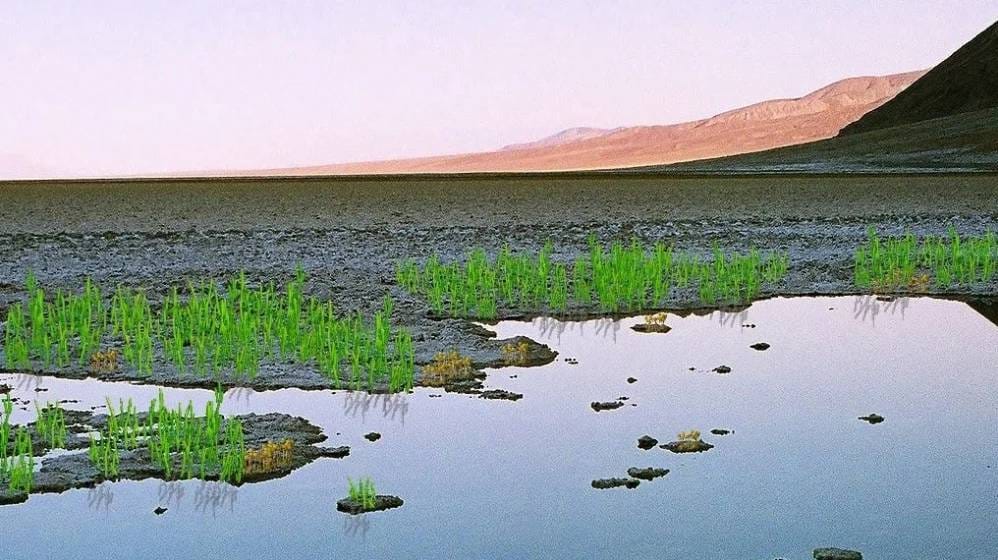
Artistic image of primeval plants of Earth
However, higher levels of oxygen also caused fires, and oxygen fires are limited. The oldest pieces of coal were found in rocks formed about 430 million years ago. Since when the oxygen is less than 16 percent in the atmosphere, a fire cannot be created, oxygen must have been higher than this level at that time.
On the contrary, the absence of coal or the presence of cracks in coal records indicates that oxygen has decreased several times since then. This happened about 390 million years ago, shortly after the mass extinction of dryland plants at the end of the Permian in 252 million years ago. Mills says, ‘It is likely that oxygen levels have been declining since the Cretaceous period, and part of it is due to changes in the biosphere structure, which is much more susceptible to wildfires than in the past. Fire consumes oxygen and controls vegetation cover.’
Did life or the earth have more oxygen?
Enbar says, ‘As geobiologists, we usually don’t pay much attention to biology and get lost in chemistry. Everything is on the planet, and the planet is really big and moving slowly, but unstoppable and uncontrollable.’
Dasgupta says, ‘In theory, without the intervention of life and solely through planetary chemical and tectonic cycles, the oxygen of the planet would rise to these higher levels over time.’ This means that if oxygen is identified in the atmosphere of another planet, it may or may not be a sign of life. Enbar says, ‘Photosynthesis was probably essential for the current oxygen levels on Earth. In order for the Earth to have a lot of oxygen, I think we need a photosynthetic biosphere.’
But was it enough?
Enbar says, ‘It is at least acceptable to argue that if the fungus had not evolved, a carbon-rich atmosphere would not have appeared.’ Mills also agrees, ‘You needed life to start this process, but changes in the earth were also necessary to complete the process.’
James Lovelock and Lynn Margulis argued in the Gaia hypothesis that life took control of the Earth’s environment and acted to improve the planet’s biosphere. However, the events of oxygenation show that the Earth has played an equally important role in controlling the Earth’s environment and the evolution of life, so the role of the biosphere and geosphere is inseparable: according to the warehouse: ‘The earth is a living planet and how the evolution of living planets is a question that has not been answered.’

